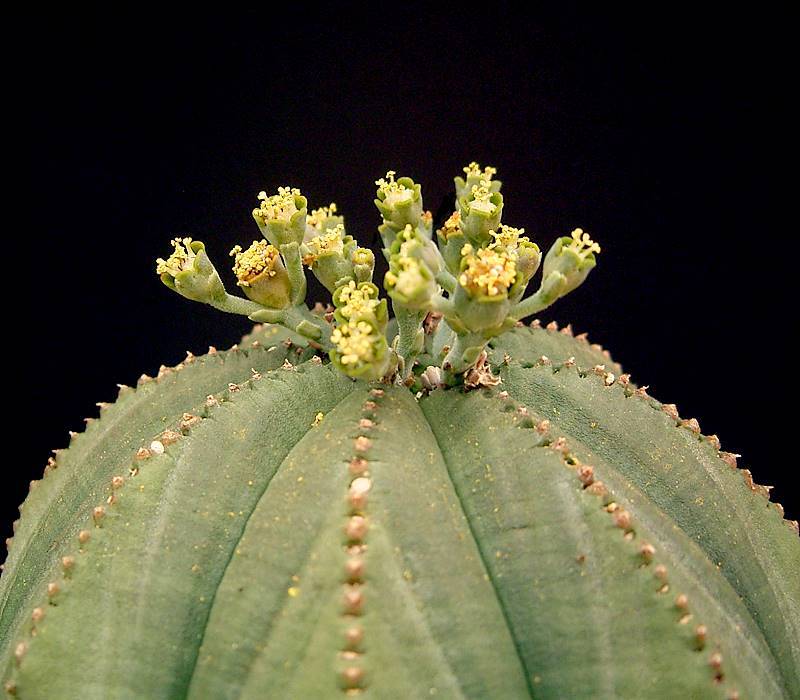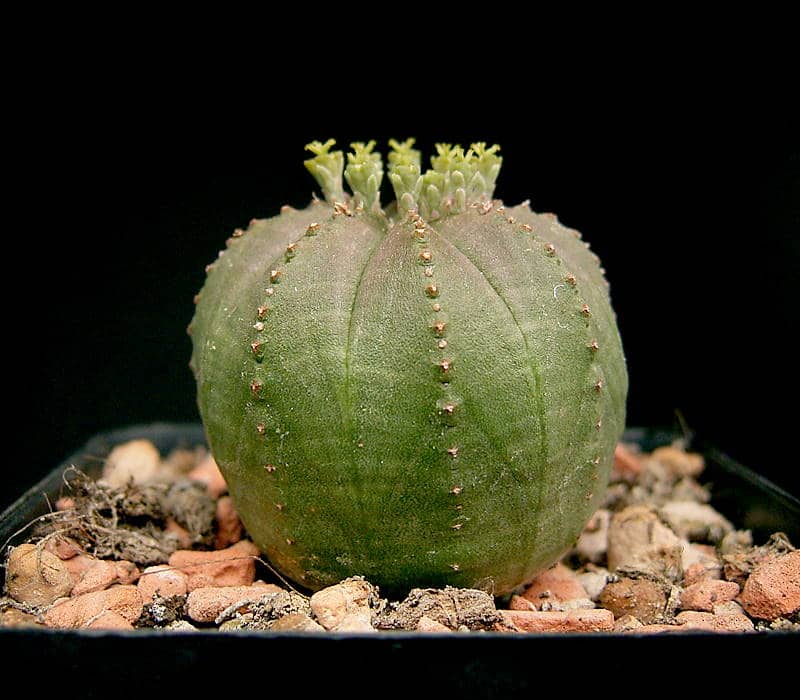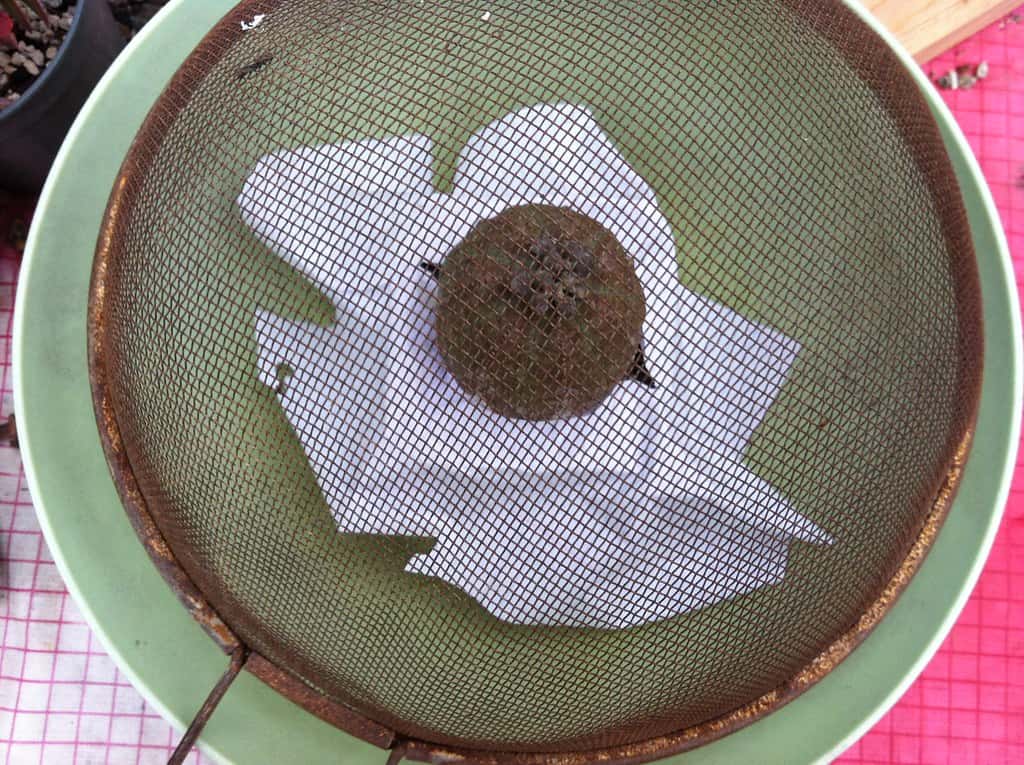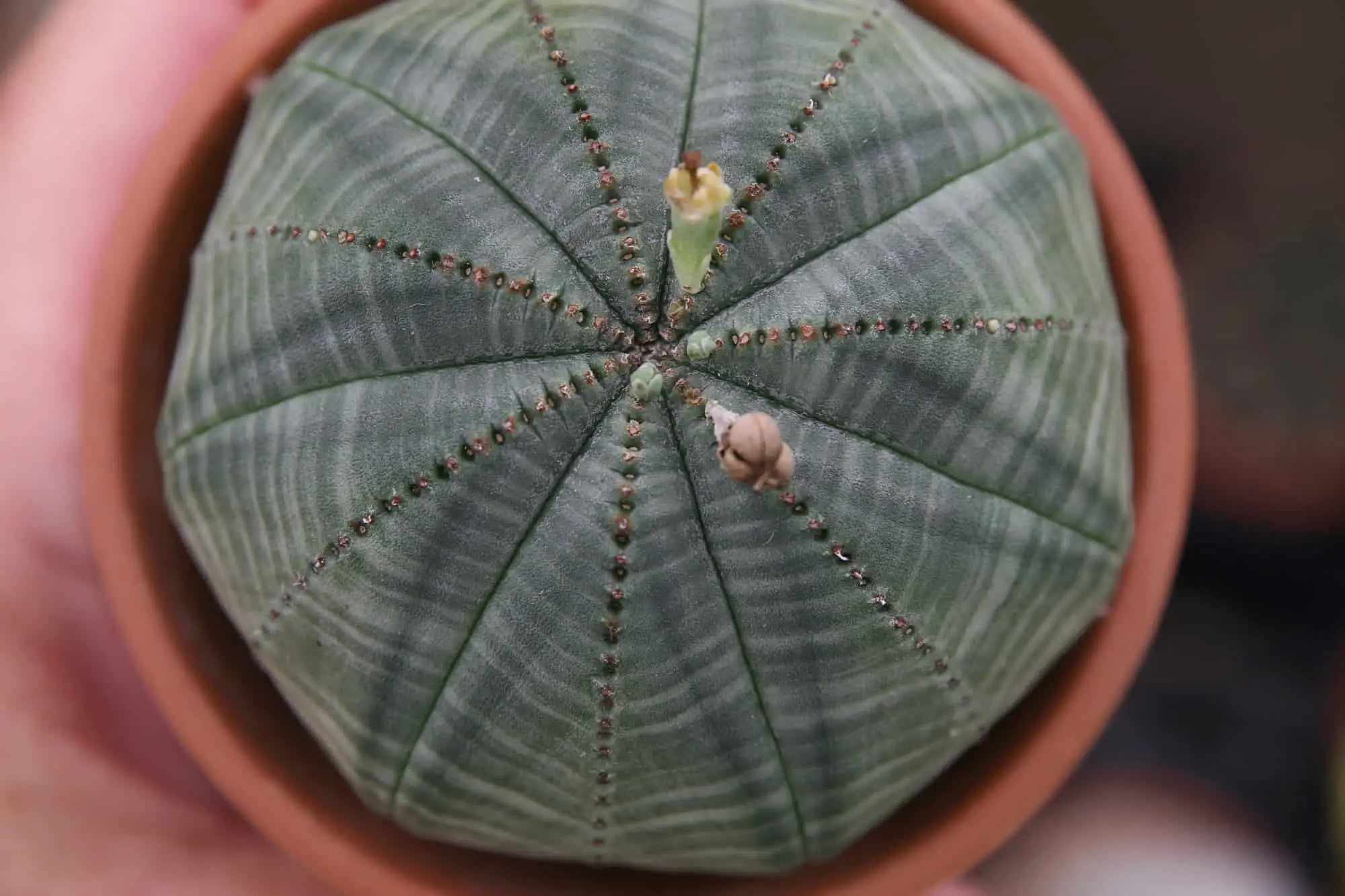Euphorbia obesa, which is commonly known as Baseball Plant, is a succulent that is prized for its funky appearance. This plant has earned the name Baseball Plant because young plants have a spherical appearance. However, it will grow taller as the plant matures. Although still fairly rare, it is the most popular succulent in the Euphorbia genus. In general, these plants are not very fussy and are good plants for growers who are new to Euphorbias.
Euphorbia obesa should be grown in a coarse soil mix and kept in an environment that is exposed to plenty of bright light during the active growing season (spring and summer). During the growing season, water thoroughly and allow the soil to dry out between watering sessions. During the dormant season (later fall and winter), Euphorbia obesa should be watered less frequently and kept completely dry if it is growing in an environment with cooler temperatures.
The rest of this article will provide a brief history of Euphorbia obesa as well as a more detailed care guide.
Quick Care Guide For Euphorbia obesa
| Scientific Names | Euphorbia obesa |
| Common Name | Baseball Plant |
| Light Requirements | Full sun near a south-facing window if grown indoors. Partial shade if grown outdoors. |
| Watering Requirements | Water succulent thoroughly and allow the soil profile to dry completely between watering sessions. Keep Euphorbia obesa dry during the winter months. |
| Soil | 1 part decomposed granite, 1 part palm and citrus potting soil, and 1 part perlite. |
| Fertilization | 10-10-10 fertilizer diluted to half strength every 6 to 8 weeks. |
| Temperature | 80-95ºF during the growing season, lower temperatures during the winter months as long as the plant remains dry. |
| Humidity | 50% to 60% |
| Toxicity | Milky, latex sap is toxic to pets or humans if ingested. The sap can also cause eye damage. |
About Euphorbia obesa
Euphorbia obesa is native to the stony hills of the Cape Province of South Africa. In the wild, these plants can be found growing in shale fragments and under dwarf karoo shrubs. In their native habitat, Euphorbia obesa is often well camouflaged and difficult to see.
These plants are somewhat rare in that they are not typically sold in nurseries. However, you can easily find them online.
History of Euphorbia obesa Cultivation
Euphorbia obesa was discovered by Peter MacOwan in 1897. He mistakenly labeled the plant as Euphorbia meloformis. This plant flowered in 1899 at which time Joseph Dalton Hooker drew a botanical description of the plant and named it.
Euphorbia obesa exploded in popularity during the early 1900s. In response to the demand, these plants were collected by the hundreds. By 1915, Euphorbia obesa was considered an endangered species. In 1931, the South African government imposed an emargo on all field-collected Euphorbia obesa plants.
Because Euphorbia obesa is so easy to propagate and grow under greenhouse conditions, this plant has become relatively popular in cultivation and there is no longer a need for field-collected Euphorbia obesa plants. In recent years, the wild population of Euphorbia obesa has started to recover due to the work of CITES and other international agreements.
Euphorbia obesa Flowers
Euphorbia obesa is dioecious, which means that the male and female flowers grow on different plants. The plant begins to produce flowers when it is between 5 and 8 years of age, and blooming typically occurs during the summer months. Like all Euphorbias, Euphorbia obesa will produce a floral arrangement on top of the plant called a cyathium. A cyathium (plural: cyathia) is a floral arrangement that consists of five bracteoles that form a cup shape.

Male Euphorbia obesa
Photographer: Frank Vincentz
Female Euphorbia obesa
Photographer: Frank Vincentz
So how do you know if your Euphorbia obesa is a male or female? Male plants will have several tiny pollen-bearing flowers within each inflorescence within the cyathium. In contrast, the female plants will only have one flower per inflorescence within the cyathium. Male plants will also have significantly more pollen.
Although you do not need a male and female plant for the plants to experience a bloom, you do need male and female plants if you want seeds. To produce seeds, the female plant must be hand-pollinated with a small brush. Simply put some pollen from the male plant on a brush and rub it on the female flowers. If the pollination is successful, the female flowers will swell into a round capsule that contains up to three seeds. These capsules will burst open when the seeds ripen. Often the seeds will scatter several feet when the capsule bursts open, so some growers have come up with elaborate devices (see example below) to catch the seeds as harvesting the seeds too early can result in low germination rates.

The following YouTube video shows how to pollinate a Euphorbia obesa.
Lighting Requirements For Euphorbia obesa
Euphorbia obesa requires a significant amount of light all year. These plants do best full sun next to a south-facing window indoors and in partial shade outdoors. During the summer months, consider putting your Euphorbia obesa outside to take advantage of the sunshine and higher temperatures.
Watering Requirements For Euphorbia obesa
Euphorbia obesa has watering requirements that are typical of succulents. During the growing season (spring and summer), Euphorbia obesa should be watered thoroughly. Allow the soil profile to dry completely between watering sessions.
During the plant’s dormant period (winter months), cut back on the frequency of watering. This mimics the conditions of the plant’s natural habitat. If your Euphorbia obesa lives in an environment with cooler temperatures during the winter months, keep the plant’s soil profile dry.
Suitable Temperature Range and Humidity Levels For Euphorbia obesa
Euphorbia obesa likes warmer temperature (80-95ºF), but they will thrive in normal room temperatures during their active growing season. These plants do benefit from a dormancy period during the winter months as long as the plant remains dry. Euphorbia obesa can withstand temperatures as low as 40°F and light frost. However, too much exposure to frost will damage the plant.
Euphorbia obesa does best in an environment with humidity levels between 50% and 60%, but they will tolerate even drier conditions. Too little humidity may slow plant growth. Excessive humidity can result in a condition referred to as Euphorbia Mildew which describes a white, powdery fungus that grows on the shoot tips of various Euphorbia species. Areas of the plant affected by Euphorbia Mildew will often turn brown and corky.

Best Soil Mix For Euphorbia obesa
Euphorbia obesa should be planted in soil with good drainage. In its natural habitat, this plant lives in rocky, coarse soil. A suitable soil mix for Euphorbia obesa is:
- 1 part decomposed granite
- 1 part palm and citrus potting soil
- 1 part perlite
Repotting Euphorbia obesa
Euphorbia obesa only needs to be repotted when it starts to outgrow its container. They do not need to be transferred to a larger pot every year. When repotting your Euphorbia obesa, put fresh soil in the container.
Fertilizing Euphorbia obesa
During the growing season, apply a balanced (10-10-10) fertilizer diluted to 1/2 strength every 6 to 8 weeks. If a white crust begins to form on the soil surface, flush the soil profile and cut back on the frequency of fertilization.
Why Is My Euphorbia obesa Corking?
A common problem succulent growers have with Euphorbia obesa is corking which describes brown spots that develop with age. Corking typically starts at the bottom of the plant and advances up. While rotting areas will feel mushy or squishy to the touch, corking will feel firm.

Sunburned areas are often confused with corking. If you have recently relocated your Euphorbia obesa to a spot with significantly more sun exposure, your plant may be burned. In contrast to corking, burns often appear as patches. Although these plants do well in full sun, they do need to be introduced to increased light levels gradually.
As previously mentioned, corking is a natural part of the aging process and is generally not cause for concern. Unfortunately, corking will eventually spread enough to significantly reduce photosynthesis which will lead to the plant’s death.
Is Euphorbia obesa Toxic?
Like other Euphorbias, Euphorbia obesa is toxic. It has a milky, latex sap that can damage your eyes. For this reason, it is important to wear gloves when handling this succulent. The sap from Euphorbia obesa can also cause mouth irritation and vomiting if ingested by pets or humans.

